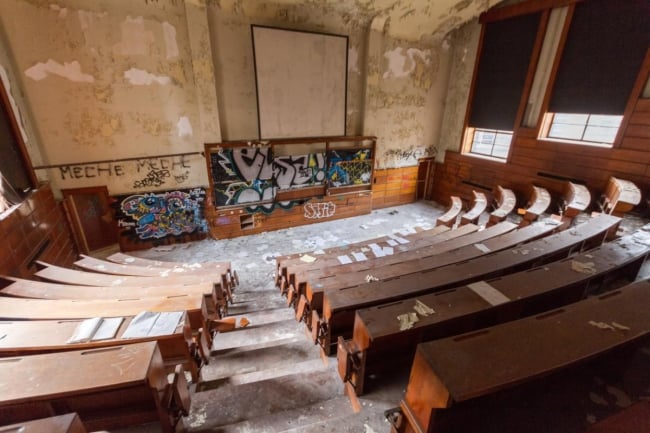You have /5 articles left.
Sign up for a free account or log in.

Istockphoto.com/OK-Photography
When Mount Ida College -- a small, private college just outside Boston -- announced in 2018 that it would close, students were left scrambling.
The teach-out plans put in place did not cover all programs. Many students in good standing who were automatically admitted to the University of Massachusetts at Dartmouth couldn’t make the 70-plus-mile drive to campus each day. Students with loans received little information about discharges and were only directed to their loan servicer.
A new report from the left-leaning think tank New America examines what happened at Mount Ida and 11 other colleges that recently closed. The report, “Anticipating and Managing Precipitous College Closures,” presents ways to reduce the number of colleges that shutter without warning.
Between the 2008-09 and 2016-17 academic years, more than 300 colleges in the United States shut their doors, according to the report. Some closures are inevitable, the report assumes, and as the new coronavirus continues to inflict its toll on college finances, experts agree that more colleges will be forced to close in coming years.
The biggest takeaway from the report, according to two of its co-authors, Amy Laitinen and Clare McCann, both of New America, is that regulating bodies, including accreditors, federal and state departments of higher education, and state governments, need to pay closer attention to the financial health of the institutions under their watch. Laitinen is director for higher education and McCann is deputy director for federal higher education policy at the think tank's education policy program.
Financial responsibility tests often lag by several years, meaning the data are old by the time they are released. Current tests are also sometimes gamed by institutions, according to the report. The Government Accountability Office found that the Education Department’s financial composite score “has predicted only half of closures since the academic year 2010-11.”
Significant declines in enrollment and retention rates, program and course cancellations, and underperformance on student achievement could all be signs of financial distress at an institution, the report states.
Effective leadership is also critical for keeping colleges open, said Jamienne Studley, president of the Western Association of Schools and Colleges Senior College and University Commission, a regional accreditor, and co-author of the report.
"Every story is different," Studley said. "Institutional failures range from tiny independent colleges to enterprises within complex corporate entities."
She added that accreditors and other regulatory bodies must judge “the ability of the board to assess the situation, and not to be clouded by factors ranging from corporate profitability to emotional attachment to the history of the school.”
Once a closure is definite, colleges can take several steps to inform students, faculty and staff and provide them with adequate planning time and resources.
The report recommends a teach-out agreement that requires colleges to follow through, as opposed to just a plan. Ensuring student records are accessible and without holds is also a must.
Ed Wingenbach stepped up to helm Hampshire College in July of last year after a previous administration explored mergers, prompting some of the college's backers to fear it was headed for closure. He’s since focused on righting the ship and establishing Hampshire for a long future. Still, he is creating contingency plans so that in the event of a possible closure, students aren’t left hanging. These plans include agreements with the state department of education about student records access.
For colleges trying to head off a potential closure, Wingenbach stressed the need for realistic goal setting.
Hampshire leadership had to “come up with a realistic, viable business plan that worked from the most conservative assumptions about revenue on every level and stretch that out over five years,” he said. “I think what a lot of colleges do, when they think they’re in trouble or headed for trouble, is they build future projections that assume that they’re going to bring in more students and that those students are going to bring in more net revenue per student, and that their costs will go down.”
Keeping students and staff informed of changes is also crucial, according to the New America report. New federal regulations will require colleges to notify students and staff after their accreditors ask for a teach-out plan.
“Students should also be notified of other high-risk changes to the school’s structure, such as mergers, changes in ownership, and changes in control,” the report states. “And colleges should be required to provide disclosures to students by their accreditors when agency actions are taken.”
Laitinen and McCann emphasized that the steps listed in their report should be considered before a closure is around the corner, not after.
The new coronavirus will heighten financial challenges for many colleges.
“All sectors and all types [of colleges] are going to be impacted” by the virus, said David Tandberg, vice president for policy research and strategic initiatives at the State Higher Education Executive Officers Association and another co-author of the report. “Those that are coming into this crisis in an already precarious situation are going to be the ones that are most impacted.”
Not only could the coronavirus yield more college closures, but more of them could be seemingly out of the blue.
“Because of the urgency of this situation, schools are being granted a lot of flexibility” from regulating bodies, Laitinen said. “Right now, we may be on the brink of more precipitous closures.”




